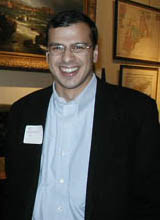New York New Visions Tackles “Sustainable” New York Future

After Mayor Bloomberg’s December announcement of his PlaNYC
initiative to prepare for a sustainable New York of 9 million people by 2030, New York New Visions, the group of architects and planners originally organized around Ground Zero rebuilding, announced it was expanding its scope to tackle the new challenge. Last night, in a stark white room in the basement of the American Institute of Architects building in Greenwich Village, a collection of almost equally stark white faces began reimagining the New York of the future.
 Rohit Aggarwala, the management consultant tasked by Bloomberg with heading up the new project (pictured right), began by laying out the PlaNYC goals, a laundry list of urban niceties that it should be hard for anyone to disagree with: more housing, parks within a 10-minute walk for all residents, a well-maintained transportation grid, cleaner air and land and water. (All these were in the newspaper insert the city placed in local newspapers back in December; if you missed it, you can still download
Rohit Aggarwala, the management consultant tasked by Bloomberg with heading up the new project (pictured right), began by laying out the PlaNYC goals, a laundry list of urban niceties that it should be hard for anyone to disagree with: more housing, parks within a 10-minute walk for all residents, a well-maintained transportation grid, cleaner air and land and water. (All these were in the newspaper insert the city placed in local newspapers back in December; if you missed it, you can still download
one from the mayor’s website.) Noting that "sustainability" is a "terribly overused word," Aggarwala nonetheless offered his own
definition: "a city that is cleaner, healthier, more reliable, and in general better."
The devil, of course, lies in the details, something that NYNV’s assembled panel of architects and planners wasted no time in pointing out to Aggarwala, even as they gave the mayor points for just raising the
questions:
- Where will the new housing for all these new New Yorkers go, and who will be living in it? "The million people who are coming are not coming with MBAs," noted Bloomberg’s former Housing Preservation and Development Commissioner Jerilyn Perine, saying the city needs to be "screaming our heads off for a new [federal] public housing program."
(Less seriously, she also suggested "trading Staten Island to New Jersey for Newark.") - "I don’t want to be the harbinger of doom here," began structural engineer Joseph Tortorella, "but I will be." The flood of new construction already underway in the city, he said, is already creating a rush to use non-union labor to keep up with the workload, something he worries could lead to "a war in this city" that will make inflatable rats seem tame. The quality of work is also already at "a dangerous level," he said, with city building sites averaging one collapse a week.
- How will all this be paid for, and what gets cut from the agenda if the money falls short? "This is a great PR beginning," said former City Planning Commission chair Donald Elliott, stressing he meant that as a compliment. "But you’re going to have to get into some evaluation of the opportunities and constraints."
And that’s not even getting into some of the bigger questions about
PlaNYC: Will new residents, most expected to be immigrants from Asia and Central and South America, really "bring jobs" with them, as Aggarwala asserted? If the city swells to 9 million people, what happens to the surrounding suburbs? And while the "GreeNYC" portion of the plan sets a laudable goal of cutting city carbon emissions by 30% (and cleaning up pollution), there’s little else about preparing for what’s likely to be a radically altered climate 23 years hence. Talk of a "more reliable" New York is likely to sound quaint if the Stillwell Avenue subway terminal has been washed out to sea.
NYNV has scheduled working group meetings the next three Fridays to follow up on last night’s meeting, but the more interesting bit will likely be the public town hall meetings that Aggarwala promised would be announced soon. That’s when the mayor should hear from not just those who hope to design the future New York, but those who hope to live in it.
Photo: SvdR on Flickr